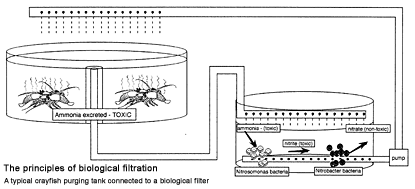Aquaculture: Water Quality and Disease
One of the most common reasons for disease and mortality in land-based aquaculture in Australia, is due to problems with water quality. Water quality has a direct effect on the health of aquatic animals. Some of the most influential factors affecting water quality are temperature, dissolved oxygen, pH, salinity, suspended solids, toxic waste levels such as ammonia and flow rates.
With this in mind, it is important that all aspects of water quality are monitored by the farmer, records kept on a daily basis and levels manipulated so they fall within acceptable ranges.
Water quality standards for finfish


(ppm = Parts per million)
(ppb = Parts per billion)
The principles of biological filtration
Biological filtration is an essential requirement of any recirculating fish holding facility. Its primary function is to break down toxins excreted by fish. Ammonia is a dissolved toxin released by fish metabolism that breaks down to form nitrite. Both ammonia and nitrite are toxic to fish. Biofilters are designed to remove these compounds from the water by the use of nitrifying bacteria. One group of bacteria, the Nitrosomonas bacteria, can convert ammonia to nitrite, and another group, the Nitrobacter bacteria, convert nitrite to the relatively non-toxic compound, nitrate (see page 6 for acceptable levels).
Most biofilters have substrates made of coarse gravel shell or sponge which provide a large surface area. The substrate is impregnated, either naturally or artificially with nitrifying bacteria and the water is passed through the substrate, where the ammonia and nitrite are broken down by the bacteria.
There are several points to remember when setting up a biological filtration system to gain maximum efficiency:
•The filter bed requires several weeks conditioning, using a small number of animals in the tank, to
introduce the necessary bacteria. If this is not done, then the inoculation of commercially available
bacterial preparations will be required.
•In order to operate efficiently, the biofilter requires oxygen. The breakdown of ammonia stops if the
dissolved oxygen level falls below 2mg O2/L, so it is vital that the water entering the biofilter be as
close to oxygen saturation as possible.
•Optimal temperature for the bacteria is 28ºC-36ºC although they will operate quite effectively at
lower temperatures. They will, however die at 58ºC and stop growing in any biofilter held below
12ºC.
•The optimum pH for the bacteria is pH 8. However, in cases where ammonia levels have become
dangerously high, the toxicity is reduced if the pH is dropped to 6. It is therefore necessary to
maintain a balance between these two factors.
•To maximise the bacterial efficiency, the substrate must be evenly covered with the flow of water.
•Biofilters should not be shock loaded (i.e., a large number of animals placed in the system at one
time, excreting a large volume of waste products).
The amount of bacteria established in the filter will only operate efficiently for the previously established stocking density. If more animals are required to be added to the system, they should be introduced gradually to allow the bacteria time to multiply.
If large volumes of solids are being produced, it may be necessary to install a sedimentation tank. This will remove any solid particles from the water before it enters the biofilter. These tanks are designed to allow a slow water flow which enables the solid particles to settle on the bottom where they are tapped or siphoned out of the system.
It should be noted that in situations where shock loading occurs such as crayfish purging tanks, biological filtration can be very hard to manage and if the water is available, a flow-through system is recommended.

by Department of Fisheries - Government of Western Australia
This article hasn't been commented yet.


Write a comment
* = required field